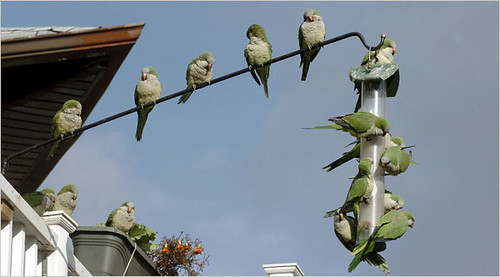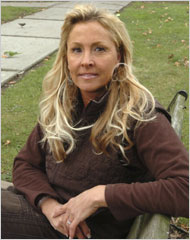 ON THE LINE Quaker parrots, which are actually monk parakeets, congregating at a bird feeder in Edgewater, where some 230 of them make their home. Alan Zale for The New York TimesON a rainy afternoon recently in this river town, many of its noisiest — and possibly best-loved — residents were snug in their nests in the trees across from the Salsa, a restaurant on River Road.
ON THE LINE Quaker parrots, which are actually monk parakeets, congregating at a bird feeder in Edgewater, where some 230 of them make their home. Alan Zale for The New York TimesON a rainy afternoon recently in this river town, many of its noisiest — and possibly best-loved — residents were snug in their nests in the trees across from the Salsa, a restaurant on River Road.
The parrots of Edgewater were safe and dry. The small lime-green birds, which are actually monk parakeets, also known as Quaker parrots, seemed unperturbed by a falcon perched high in a tree — the predatory bird could be seen from the restaurant’s front window. Earlier, near the restaurant, four of the parrots formed a squadron and, with their signature screech, flew in a visitor’s direction and were gone in an instant.
“We all love them,” said Susann Fletcher, a co-owner of the Salsa and a former Broadway actress. “They give the community its flavor.”
The Quaker parrots have lived in Edgewater for more than 30 years. How they came to be an ornithological fixture here is a matter of speculation. The most accepted explanation is that they escaped from a shipping crate at Kennedy International Airport in the late 1960s and flew first to Brooklyn before settling in Edgewater; there are some parrots in Brooklyn, too.
Now, legislation is pending in the New Jersey Senate to remove them from the state’s list of potentially dangerous species. Black bears are also on that list. Advocates say the birds made the list because officials were afraid they would jeopardize indigenous species (the parrots are South American in origin) and perhaps damage crops.
Ms. Fletcher, an Edgewater resident for 15 years, and Michelle Schotanus, the restaurant’s other owner, monitor and protect the birds, rescuing two or three injured ones a year. Ms. Fletcher said they also defend them from occasional detractors who say they’re too noisy and a nuisance.
“I asked a customer recently if he wanted anything else,” she said, “and he said, ‘Yeah, a green bird on a stick.’ I said: ‘Don’t you dis our parrots! They’re gorgeous birds.’ ”
She acknowledged that the birds — which also congregate in a nearby park and can be seen elsewhere in Edgewater and even in nearby Leonia — are especially animated in the morning. They travel in formation and build huge nests in the nearby trees. One nest visible from the restaurant is approximately four feet long and a foot wide. Ms. Fletcher said they also gather at dusk and have noisy bird conversations. “They have a lot to say to each other at the end of the day,” she said.
State Assemblywoman Joan Voss, a Democrat from Fort Lee, who has been working on legislation to protect the birds since 2005, estimated there are some 200 to 230 parrots in Edgewater, up from about 190 in the past three years.
Before 2005, the Public Service Electric and Gas Company periodically cracked down on the birds, imperiling them by tearing down their nests from utility poles during the breeding season. PSE&G maintained that the nests were a potential fire hazard. But since then, the utility and the parrot advocates have reached a truce, and PSE&G has agreed not to knock down nests during the breeding season.
 FOR THE BIRDS Alison Evans-Fragale is a protector of the parrots. Alan Zale for The New York TimesStill, Alison Evans-Fragale, an advocate for the birds who negotiated with PSE&G and has conducted tours of the parrot sites, said legislation remained crucial for the parrots to continue to flourish and survive. Referring to the birds’ designation as a potentially dangerous species, she said on her Web site, in a message aimed at state legislators: “As long as they remain on the list, humane treatment of the birds is not insured, and the birds can be indiscriminately killed. It’s within your power to prevent this awful practice.”
FOR THE BIRDS Alison Evans-Fragale is a protector of the parrots. Alan Zale for The New York TimesStill, Alison Evans-Fragale, an advocate for the birds who negotiated with PSE&G and has conducted tours of the parrot sites, said legislation remained crucial for the parrots to continue to flourish and survive. Referring to the birds’ designation as a potentially dangerous species, she said on her Web site, in a message aimed at state legislators: “As long as they remain on the list, humane treatment of the birds is not insured, and the birds can be indiscriminately killed. It’s within your power to prevent this awful practice.”
The legislation to remove the parrots from the list passed in the Assembly in May 2007, but is stalled in the Senate, Assemblywoman Voss said. She added that she feared it would remain stalled through the end of the session in June because, in the current economic downturn, lawmakers have other priorities. “With all the stuff happening in the state now,” she said, “parrots are not a priority.” She said the legislation would have to be reintroduced if it did not pass this session.
In his pizza shop across from the River Road park where the parrots congregate, George Prifti, 37, also keeps a careful eye on the parrots, a daily presence in the trees. He pointed out six nests in two trees.
“People love the parrots,” Mr. Prifti said. “I love them.” He said that on weekends, especially, his customers like to watch the birds from the restaurant, and some take pictures of them. “It’s something positive,” he said. “The birds are good for business.”